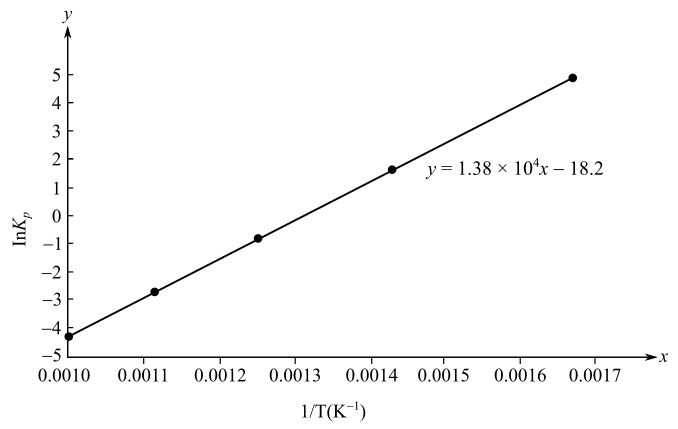
The dependence of the equilibrium constant of a reaction on temperature is given by the van't Hoff equation:
where C is a constant. The following table gives the equilibrium constant
KP |
138 |
5.12 |
0.436 |
0.0626 |
0.0130 |
TOO |
600 |
700 |
800 |
900 |
1000 |
(a) Determine graphically the
How does this equation support the prediction based on Le Châ�telier's principle about the shift in equilibrium with temperature? (c) The vapor pressures of water are 31.82 mmHg at
Interpretation:
The
Concept Introduction:
Achemical equilibrium is a state of the chemical reaction when the rate of forward reaction becomes equal to the rate of reverse reaction and the concentrations of the products and reactants become constant, which are known as equilibrium concentrations.
When energy is released in a reaction, the reaction is called exothermic, and the reactions in which energy is absorbed are endothermic reactions.
According to Le Chatelier’s Principle, when a system at equilibrium is subjected to any change, the system tries to undo the effect of that change by shifting its equilibrium in the desired direction.
The van't Hoff equation provides information about the temperature dependence of the equilibrium constant.
Answer to Problem 125AP
Solution:
(a)
(b)
According to Le Chatelier’s principles, increase in temperature favors the forward endothermic reaction, and decrease in temperature favors an exothermic reaction.
(c)
Explanation of Solution
a)The
The

The slope of the plot is
Here,
Substitute the values of
The
b)The following equation support the prediction based on Le-Chatelier’s principle about the shift in equilibrium with temperature
The vant Hoff’s equation at two different temperatures is
Here,
From (1) and (2):
An endothermic reaction has
Then, temperature is
In a reversible reaction at equilibrium, when the equilibrium constant is more, the products are also more or the rate constant of forward reaction is more, and hence the products are more. According to LeChatelier’s principle, an increase in temperature favors endothermic reaction, and a decrease in temperature favors exothermic reaction.
c) Molar heat of vaporization of water
The vapor pressure of water is
From vant’s Hoff equation,
Here,
Substitute the values of
On further solving
The molar heat ofvaporization of water is
Want to see more full solutions like this?
Chapter 15 Solutions
BURDGE CHEMISTRY VALUE ED (LL)
- Determine the change in Gibbs energy, entropy, and enthalpy at 25°C for the battery from which the data in the table were obtained.T (°C) 15 20 25 30 35Eo (mV) 227.13 224.38 221.87 219.37 216.59Data: n = 1, F = 96485 C mol–1arrow_forwardIndicate the correct options.1. The units of the transport number are Siemens per mole.2. The Siemens and the ohm are not equivalent.3. The Van't Hoff factor is dimensionless.4. Molar conductivity does not depend on the electrolyte concentration.arrow_forwardIdeally nonpolarizable electrodes can1. participate as reducers in reactions.2. be formed only with hydrogen.3. participate as oxidizers in reactions.4. form open and closed electrochemical systems.arrow_forward
- Indicate the options for an electrified interface:1. Temperature has no influence on it.2. Not all theories that describe it include a well-defined electrical double layer.3. Under favorable conditions, its differential capacitance can be determined with the help of experimental measurements.4. A component with high electronic conductivity is involved in its formation.arrow_forwardTo describe the structure of the interface, there are theories or models that can be distinguished by:1. calculation of the charge density.2. distribution of ions in the solution.3. experimentally measured potential difference.4. external Helmoltz plane.arrow_forwardIndicate the correct options when referring to Luther's equation:1. It is not always easy to compare its results with experimental results.2. It depends on the number of electrons exchanged in the species involved.3. Its foundation is thermodynamic.4. The values calculated with it do not depend on temperature.arrow_forward
- Indicate which of the unit options correspond to a measurement of current density.1. A s m-22. mC s-1 m-23. Ω m-24. V J-1 m-2arrow_forwardIndicate the options that are true when referring to electrode membranes:1. The Donnan potential, in general, does not always intervene in membranes.2. There are several ways to classify the same membrane.3. Any membrane can be used to determine the pH of a solution.4. Only one solution and one membrane are needed to determine the pH of that solution.arrow_forwardCalculate the maximum volume of carbon dioxide gasarrow_forward
- In galvanic cells, their potential1. can be measured with a potentiometer2. does not depend on the equilibrium constant of the reaction occurring within them3. is only calculated from the normal potentials of the electrodes they comprise4. can sometimes be considered a variation in a potential differencearrow_forwardIf some molecules in an excited state collide with other molecules in a ground state, this process1. can occur in solution and in the gas phase.2. can be treated as a bimolecular process.3. always results in collisional deactivation.4. does not compete with any other process.arrow_forwardRadiation of frequency v is incident on molecules in their ground state. The expected outcome is that1. the molecules do not change their state.2. the molecules transition to an excited state.3. the molecules undergo a secondary process.4. collisional deactivation occurs.arrow_forward
 Chemistry & Chemical ReactivityChemistryISBN:9781337399074Author:John C. Kotz, Paul M. Treichel, John Townsend, David TreichelPublisher:Cengage Learning
Chemistry & Chemical ReactivityChemistryISBN:9781337399074Author:John C. Kotz, Paul M. Treichel, John Townsend, David TreichelPublisher:Cengage Learning Chemistry: An Atoms First ApproachChemistryISBN:9781305079243Author:Steven S. Zumdahl, Susan A. ZumdahlPublisher:Cengage Learning
Chemistry: An Atoms First ApproachChemistryISBN:9781305079243Author:Steven S. Zumdahl, Susan A. ZumdahlPublisher:Cengage Learning Chemistry & Chemical ReactivityChemistryISBN:9781133949640Author:John C. Kotz, Paul M. Treichel, John Townsend, David TreichelPublisher:Cengage Learning
Chemistry & Chemical ReactivityChemistryISBN:9781133949640Author:John C. Kotz, Paul M. Treichel, John Townsend, David TreichelPublisher:Cengage Learning Chemistry by OpenStax (2015-05-04)ChemistryISBN:9781938168390Author:Klaus Theopold, Richard H Langley, Paul Flowers, William R. Robinson, Mark BlaserPublisher:OpenStax
Chemistry by OpenStax (2015-05-04)ChemistryISBN:9781938168390Author:Klaus Theopold, Richard H Langley, Paul Flowers, William R. Robinson, Mark BlaserPublisher:OpenStax Introductory Chemistry: A FoundationChemistryISBN:9781285199030Author:Steven S. Zumdahl, Donald J. DeCostePublisher:Cengage Learning
Introductory Chemistry: A FoundationChemistryISBN:9781285199030Author:Steven S. Zumdahl, Donald J. DeCostePublisher:Cengage Learning Principles of Modern ChemistryChemistryISBN:9781305079113Author:David W. Oxtoby, H. Pat Gillis, Laurie J. ButlerPublisher:Cengage Learning
Principles of Modern ChemistryChemistryISBN:9781305079113Author:David W. Oxtoby, H. Pat Gillis, Laurie J. ButlerPublisher:Cengage Learning





